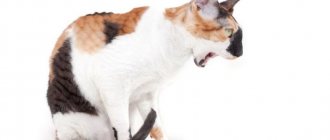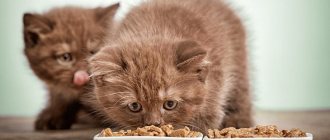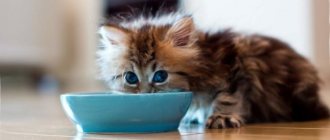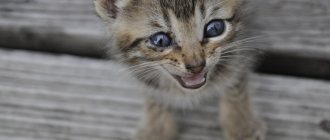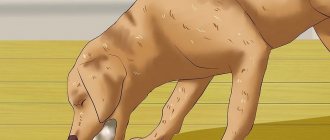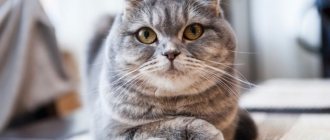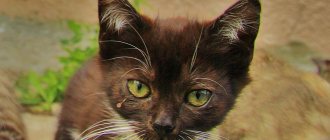In this article, we explained why a cat vomits white foam, which symptoms are harmless, and which require contacting a veterinarian. You will also learn how to provide first aid to a cat, diagnose and treat it.
The cat vomits white foam in different cases. This physiological process can greatly frighten the owner of the animal. But there is no need to be afraid. Vomiting is often a normal protective reaction of the body. In the article we looked at the causes of vomiting, as well as treatment methods and preventive measures.
A cat, like a person, can experience various reactions in the body. White foam vomiting can occur in a cat for a variety of reasons. Let's look at what can trigger vomiting in a cat.
The cat is vomiting white foam
Natural Causes of White Vomit
A cat may burp white foam for a variety of reasons. This physiological feature is a protective mechanism that rids the body of unnecessary substances. Some cases of vomiting may be symptoms of various diseases that put the cat's health at risk. However, this process can be natural.
Natural causes of white vomit include:
- Binge eating
With an unbalanced diet, your pet may vomit white vomit. This often occurs in cats that eat dry food and do not observe the required intervals between meals. Dry food is a dehydrated food, so you need to control the water balance. If this rule is not followed, dry food may swell in the stomach and cause it to become full. As a result, the gag reflex will work.
Overeating in a cat
- Getting hairballs into the stomach
Cats are clean animals that lick themselves every free minute. They undergo seasonal molting twice every two years. During this period, wool falls out with particular force. When washed, the fur goes directly into the cat's stomach. The body reacts to this and clears itself of hair through vomiting.
During the shedding period, a cat swallows a lot of fur while washing itself.
- Ingestion of objects and other foreign bodies
Curious animals are interested in all objects in the house. They often swallow small objects that end up in the digestive tract or get stuck in the throat. The body undergoes a cleansing process, during which the cat burps. Vomiting allows you to get rid of a foreign body.
A cat can swallow small objects
- Taking medications
Some medications have side effects. Your cat may vomit if she is taking medications to treat constipation.
Drug poisoning
- Puberty
On the way to physiological maturity, a cat begins to undergo changes in its body. In some cases, she may burp saliva and white foam.
Causes of vomiting in cats and kittens
Cat vomits yellow liquid with foam
Common factors that cause cats to vomit white foam include not enough or too much food, uremia, and drug poisoning. Each of them has additional clinical signs that the pet owner should pay attention to.
Vomiting with drooling may be due to poisoning
Fasting or overeating
Pets that have undergone spaying or neutering procedures no longer have control over the amount of food they eat. The symptoms are complemented by pieces of overcooked food in white foam. Rapid absorption of food without worry ends with its removal through the nasal passages and oral cavity. Overeating can be determined by mucous contents, large food particles, white foam, and diarrhea.
Prolonged fasting in cats causes a protective reflex due to the body's attempts to get rid of accumulated gastric juice. It irritates the mucous membranes of the stomach, causing reverse peristalsis.
Note! A phenomenon called a hungry gag reflex is observed in cats that careless owners do not feed for more than 48 hours.
Uremia
Cats also vomit foam in cases of renal failure accompanied by uremia. Clinical signs of uremic syndrome are presented:
- drowsiness;
- weakness;
- refusal to communicate;
- a sharp decrease in body weight;
- lack of appetite;
- bad breath.
Animals suffer from a persistent increase in blood pressure, anemia and acid-base balance disorders.
For your information! Cats diagnosed with the disease are registered with a veterinarian and take certain medications for life.
In case of drug poisoning, your pet urgently needs help
Drug poisoning
Non-standard reactions may appear during the treatment or prevention of certain diseases. A cat may vomit when taking:
- potent antibacterial drugs;
- laxatives for constipation;
- medicines against helminths.
Important! Self-medication with any medications can provoke a pathological condition.
Main causes of vomiting
Owners often ask why a cat vomits? Vomiting can occur for various reasons. In some cases, this is a natural process that works as a protective mechanism and is not dangerous to health. Sometimes vomiting can be a symptom of diseases that are dangerous to the health of the animal.
The main causes of vomiting in cats
1. Entry of foreign objects
If there is a small child in the family, there is a possibility that the animal may swallow a small toy and the cat may vomit white foam. You should be careful and hide dangerous objects from your cat.
2. Hair getting into the stomach
During seasonal shedding, a cat sheds more hair than usual. When washing, your pet may swallow a lot of hair, which will cause the body to vomit.
3. Overeating
With a dehydrated diet and poor water balance, a gag reflex may occur. Dry food pellets build up and fill the stomach, causing the cat to vomit.
4. Worms
Vomiting can be a symptom of helminthiasis.
5. Load on the vestibular apparatus
Increased workload, long active games, driving in a car at high speed can cause nausea.
Fasting or overeating
Hungry cat
With prolonged fasting, the cat may vomit white foam. This is not dangerous for the body; nausea in this case is a normal physiological process. This is due to the fact that gastric secretions irritate the walls of the stomach and come out.
The cause of vomiting depends on the color of the discharge. If your cat is vomiting red, there may be internal damage to the body.
If the animal rarely vomits, then there is no need to worry. Vomiting is a protective reaction of the body. But if there are frequent cases of nausea, the animal should be taken to the doctor.
Overeating can also cause you to vomit white foam. An unbalanced diet, poor water balance with a dehydrated diet, and incorrect feeding rates are dangerous to health.
The cat has eaten too much
Do not keep the food bowl in the public domain. The pet may exceed its limit. In the long term, this can lead to obesity and digestive system disorders.
If your cat eats dry food, there must be a bowl of water next to the food.
Vomiting once will not harm your pet. In this case, it is worth reviewing his diet, studying the basics of a balanced diet and finding out the feeding standards specifically for your animal.
If you experience frequent nausea, you should consult your doctor.
Uremia
Uremia in a cat
Uremia is poisoning due to renal failure and impaired renal function. Cats are particularly susceptible to this disease. It is not an independent disease, but manifests itself when the excretory system is disrupted.
Poor nutrition can cause uremia.
Vomiting white foam is the most common symptom of uremia. If your pet has constant nausea, he may be poisoned. Uremia is not an independent disease, so you should consult a doctor to find out the real problems of the body.
To prevent uremia, it is worth following preventive measures. You need to give your cat a balanced diet that includes all the vitamins and minerals a cat needs. Some breeds are more susceptible to uremia, so it is worth checking with a veterinarian. The main condition is not to worsen the pet’s condition and eliminate the disease at the first stage.
Drug poisoning
The cat was poisoned by medicines
Cats love to taste different things in the house. It is worth keeping things dangerous to the cat away from its eyes, and especially medications.
Medicines can be dangerous for the animal. In case of poisoning, the following symptoms appear:
- Drowsiness
- Unsteady gait
- Weakness
- Enlarged pupils
- Trembling throughout the body
- Vomit
Vomiting white foam is one of the symptoms. If your pet suddenly vomits, but you are sure that his food is correct, it is worth checking that everything is in its place. If you notice that your cat has swallowed a medication, you need to take action.
In case of intoxication, you need to crush 2-4 tablets of activated carbon and put it in the cat's mouth.
The cat may develop diarrhea, so a bowl of water should be visible. Important: Under no circumstances should you give antiemetic medications.
If complications arise, you should consult a doctor.
Causes of foamy vomiting in cats
The causes of white foam vomiting in cats are very diverse - from natural to deadly. If this happens more than once, you should consult an experienced veterinarian. Repeated rejection of food by the stomach indicates problems in some part of the body - from the esophagus and gallbladder to the rectum.
The functioning of the digestive system in cats is the same as in humans. Food enters the stomach and remains there for a couple of hours. After this, processed foods go into the intestines. A special protective mucus is formed in the stomach; if it interacts with air, then white foamy discharge is formed. That's why a cat vomits white foam - it's just a symptom of hunger, this happens in people too. With a single attack of nausea, this option is the norm. But the relapse should not be ignored - it is necessary to take the cat to the doctor.
Physiological reasons
The natural reflex is an important defense mechanism. It helps animals get rid of harmful components - garbage, licked fur, and other foreign objects. Among the natural reasons why a cat vomits white foam are the following:
- Hairballs called trichobezoars often accumulate and form in the stomach. Cats lick themselves more than once a day; their fur becomes a tight mat in the stomach and is not digested. The appearance of a large trichobezoar provokes nausea, and eventually the cat or kitten vomits white foam. This is a defense mechanism that all mammals have. In long-haired individuals, such incidents occur more often; they are recommended to be given special medications to assist in the release of the trichobezoar. For short-haired cats, simply eating grass will be a salvation.
- A cat may vomit white foam if it has eaten too much food in a record short period of time. More often we are talking about dry food: it begins to swell inside, and there is simply not enough space for it. That is why it is worth closely monitoring the volume of portions given to your furry pet. Feedings should be distributed evenly so that the pet does not starve or pounce on food.
- The cat reacts sharply to hunger. If food does not enter the stomach for a long time, it will continue to produce the enzymes necessary for digestion. Gastric juice irritates the mucous membrane of the walls, and as a result, the cat vomits saliva with white foam from hunger.
- Some furry companions are greedy for food and do not control the process of food consumption - they eat a lot and do not feel full. Overeating occurs, and the cat vomits white foam, and undigested food is mixed in with it.
- Curious cats may accidentally swallow a foreign object. If it gets stuck in the throat, then the natural process will be nausea - mucus, foam and other stomach contents will push the foreign body out. And if it moves further into the digestive system, then you can’t do without the help of a doctor - complete or partial intestinal obstruction may occur.
- During pregnancy, cats' hormonal levels change. It is quite logical that the pet is vomiting - the owner should not worry about this. Toxicosis can periodically manifest itself in the last stage of gestation: this occurs due to the pressure of the uterus on the digestive organs and due to the concentration of certain hormones in the blood.
- During the period of sexual heat, a radical hormonal change occurs. The female will become nervous and restless. Disruptions in the gastrointestinal tract may occur, including foamy vomiting.
- Sometimes the animal reacts sharply to certain medications. A white tint and foamy consistency occur when taking antibiotics and some other drugs. If your cat continues to vomit white foam, contact your veterinarian and ask him to prescribe another, more appropriate medication.
- The stress factor should not be excluded. Nausea can be provoked by fear, a change of place of residence, excitement - even just the arrival of noisy guests.
- Carrying out operations. If your pet has recently had surgery under anesthesia, you may experience bouts of nausea. After 24-48 hours, the unpleasant effects of anesthesia should completely disappear.
- If your pet has been vaccinated, then attacks of nausea, fever, apathy and drowsiness are possible. Normally, this condition should not last more than two to three days.
In addition to the presence of natural factors, there are a number of diseases and anomalies. They require maximum attention.
Foamy vomiting as a sign of illness
Unusual accompanying symptoms may indicate diseases of varying severity. The owner of the animal can only make an assumption regarding the disease, and an accurate diagnosis is made exclusively in a veterinary hospital. Here are the most likely diseases of cats when vomiting white foam:
- Infections of viral and bacterial origin. They provoke serious disorders in all body systems and lead to complications. The most dangerous and deadly are distemper, calcivirosis, leptospirosis, etc. In addition to nausea, a sick cat will experience passivity, weakness, reluctance to eat, diarrhea, fever, salivation, and copious discharge from the eyes and nose. These situations can be extremely dangerous - you should quickly get to an experienced doctor for examination.
- Diseases of the digestive system. Almost all gastrointestinal diseases are accompanied by one-time or constant vomiting, as well as diarrhea or constipation. The animal refuses to eat or, on the contrary, eats a lot. But even with a good appetite, your pet can lose weight.
- Infection with helminths. Helminthiasis (infection with worms) has a whole list of symptoms: hair loss, diarrhea/constipation, mood and appetite swings, decreased immunity, the appearance of worms in stool or vomit. This condition is quite dangerous for the pet - without treatment it can die.
Perhaps the most dangerous option is infection with rabies. In this case, foamy saliva comes out of the pet’s mouth, which is sometimes accompanied by nausea. In this case, you should act urgently - take the animal to the veterinarian in a closed carrier.
Any deviation in behavior accompanying foamy vomiting should alert the owner. It is worth observing the cat, and if suspicions increase, take him to the veterinarian.
Why does a pregnant cat vomit?
Pregnant cat
Pregnancy is a complex process that causes changes in the cat's body. Vomiting is one of the symptoms of pregnancy. There is no need to worry about the expectant mother; nausea is a normal process during pregnancy.
But why does the cat feel sick?
During pregnancy, hormonal levels change. The uterus increases in size, and other internal organs are compressed. The fetus can put pressure on the organs, so after the usual meal, the cat may vomit.
The cat's body becomes sensitive during pregnancy. It rejects toxic substances, resulting in frequent vomiting.
White vomit is a normal reaction, so there is no need to worry. But if blood or bile is released, you need to go to the veterinarian so as not to endanger your pet.
Types of vomiting
In most cases, the cause of vomiting can be determined by the consistency and type of vomit.
- If an animal vomits yellow foam, this means that during the digestion of food a certain amount of bile enters the cat’s stomach. This often happens with gastritis, colitis, and problems with the biliary tract. Against the background of bile secretion, the liver is cleansed of harmful microorganisms and toxic substances. Thus, a cat can vomit due to calcivirosis, feline distemper, a change in food, or a small foreign object entering the stomach.
- The animal vomits clear liquid or saliva due to a rather dangerous disease - distemper. At the same time, the cat can also vomit yellow liquid or foam, which does not contain undigested food and hairballs. With each subsequent urge, the cat gets worse, he becomes lethargic and apathetic, and hides in a dark place. When a cat vomits a clear, almost colorless liquid, its body loses water, which leads to rapid dehydration.
- It happens that a cat may vomit right after eating. The reason for this is intestinal parasites, which are found even in domestic cats. Also, a cat may regurgitate undigested food that is not absorbed by its body. This condition can manifest itself with intestinal obstruction, gastritis, colitis, hepatitis, or pancreatitis. An animal may regurgitate food it has just eaten due to a certain amount of hair that has accumulated in its stomach or due to overeating.
- If helminths live in a cat's body, the cat may well vomit worms. In such a situation, you should take preventive measures, limit your pet’s contact with people and make a visit to the veterinarian. You can start taking antiparasitic drugs only after passing a stool test, which determines the type of worms living in the animal’s body. When treating a cat for worms, clean and fresh water should always be present in its drinking bowl.
Something else interesting: Vomiting in cats and what to do if your cat vomits
White vomit in kittens
Why is the kitten vomiting?
The main reason why a kitten may vomit is poor nutrition. At a young age, the baby does not feel well about his body and does not understand the degree of saturation. Kittens can eat large amounts of food, which will lead to vomiting.
Children often end up in a new home at an early age. The owners begin to feed them dry food and solid food. The developing cat's body must get used to the new diet. Sometimes kittens can vomit when unfamiliar food gets into their stomach.
There is no need to overfeed babies. Their diet should include all the necessary nutrients. To ensure that everything is in order with the baby’s digestion, you need to feed him premium, super-premium and holistic foods, as well as fresh natural products.
How to give first aid
First aid for vomiting
Vomiting is a normal protective reaction of the body. Most often, cats vomit when they overeat, swallow their fur or large pieces of food. If after vomiting the cat feels well, plays, runs, has normal bowel movements, and a healthy appetite, then there is no reason to worry. It is enough to observe the animal during the day.
If your cat is overeating, do not feed it for 12 hours. Such unloading will benefit the body.
If your cat suddenly vomits white foam and liquid, you need to take some measures.
1. Provide plenty of fluids. Place a bowl of water in a visible place.
2. If the animal does not drink water, you need to give it water every 2 hours from a syringe or pipette.
3. If vomiting is accompanied by diarrhea, you can give Smecta powder after mixing it in warm water.
4. Within three days after poisoning, include low-fat foods in your diet.
In cases where the cat vomits frequently over a short period of time, and when vomiting blood or bile is released, you need to contact a veterinarian.
When to contact a veterinarian
Cat at the vet
Vomiting is often not dangerous for a cat. Vomiting white foam once without other symptoms is not dangerous. Sometimes nausea can be a symptom of other illnesses. You need to consult a doctor in the following cases:
· the pet vomits more than three times in a short period of time.
· blood and bile are released.
· other symptoms are present: diarrhea, cramps, high fever, weakness.
Nausea can be a symptom of dangerous diseases. It's worth keeping an eye on your pet. If you have any suspicions, you should contact your veterinarian.
Why does my pet feel sick and vomit white foam?
Veterinarians say that vomiting white foam in cats is a common symptom, and by this alone it is difficult to determine the cause of nausea. This can be either a simple dietary disorder or a dangerous disease of the gastrointestinal tract. Let's look at the main causes of white vomit in cats.
Eating disorder
The most common reason why an animal may vomit white foam is poor nutrition. If the baby has just been weaned from its mother cat, it takes time for him to adapt to eating adult animals. The gastrointestinal tract must adapt to solid food and “learn” to produce the necessary enzymes for digesting “adult” food. Veterinarians recommend feeding babies with special food.
In addition, babies often lack a sense of satiety. They eat large amounts of food, and owners must ensure that the pet does not overeat. White vomit may be a sign that your cat has eaten too much, especially if he hasn't been fed enough the previous day.
A violation of the regime, such as a hunger strike, also affects the functioning of the gastrointestinal tract. If the cat has been forced to starve for more than a day, you should not immediately give him a large portion of food, it is better to first give him a small amount of milk. During fasting, gastric juice containing hydrochloric acid corrodes the mucous walls and provokes white vomiting.
Accumulation of fur in the stomach
Cats are very clean animals. They constantly clean their fur by licking it. However, in long-haired cats this causes additional problems - long hairs get into the stomach and clog it.
The gag reflex is a protective reaction with the help of which a hairball is expelled; often an adult cat or kitten vomits for this very reason. Owners should not worry if the cat has vomited; on the contrary, a prolonged absence of vomiting and poor appetite are a signal that the animal’s body cannot cleanse itself. What to do in such a situation? Veterinarians advise giving pets special vitamins, food, or sprouting grass at home, which will improve the removal of the hairball.
How can pet owners know if the cause of vomiting is hair buildup? The pet vomits up a sticky hairball along with a large amount of foamy saliva.
Various diseases
White vomit can be a symptom of dangerous viral and bacterial diseases:
- Panleukopenia or "feline distemper". Caused by parvovirus, which is highly contagious to animals but not dangerous to humans. It affects the gastrointestinal tract, in particular the small intestine, respiratory organs, heart, bone marrow cells, and lymphatic system. Leads to general intoxication and dehydration. The incubation period lasts 3-10 days. A sick cat's temperature rises, white, mucous vomit with bile and foul-smelling diarrhea appear. The animal hides in a secluded place, often approaches a bowl of water, but does not drink due to stomach pain. The mortality rate among kittens reaches 90%.
- Calicivirus. The causative agent is calcivirus. The first signs are fever, nasal and eye discharge, and depression. A characteristic symptom of the disease is profuse salivation, which turns into foamy vomiting with bile. Babies over 1 month of age are most susceptible to the disease. Their disease often progresses to pneumonia. The mortality rate reaches 30%.
- Feline immunodeficiency (FID). Lentivirus destroys T-lymphocytes, which cause nonspecific immunodeficiency. The cat loses its appetite, begins to vomit, diarrhea and inflammation of the oral cavity appear. Cats can be vaccinated from 2 months of age.
Inflammatory processes in the gastrointestinal tract
Vomiting is often a consequence of inflammatory processes in the digestive system. Most often this is a symptom of dyspepsia, which is manifested by heartburn, stomach pain, nausea, and diarrhea. This condition is not dangerous if the baby’s owner contacts the veterinarian in time. Most often, cats are prescribed a strict diet without raw, fatty or fried foods. They are given special vitamins and food, and meat products are boiled.
When a cat vomits bile and blood, it may be a symptom of gastritis or an ulcer. In this case, the pet is prescribed medication and diet.
Coronavirus enteritis is an acute inflammatory disease caused by feline coronavirus. The virus primarily affects the epithelium of the mucous membrane of the stomach and small intestine, causing inflammation. The disease is accompanied by vomiting, diarrhea, dehydration, and the animal does not eat anything. In the acute course of the disease, the animal dies within 1-2 days.
Drug poisoning
Cats are very curious in the first months of life. They love to sneak onto a shelf or into a closet and taste everything they can reach. During such studies, the baby may confuse his own vitamins and food with medications and eat several tablets. Medicines quickly enter the bloodstream, causing intoxication of the body.
Vomiting in this case is a protective mechanism by which the cat’s body tries to get rid of toxins. Along with nausea, profuse diarrhea begins. Under no circumstances should owners be given antiemetics; on the contrary, they need to help remove dangerous substances from the cat’s body as quickly as possible.
Poisoning, accompanied by vomiting and diarrhea, often leads to dehydration. There should be a bowl of clean water next to the animal so that it can drink at any time. If it is so weakened that it cannot approach the bowl on its own, it needs to be watered from a pipette.
Worms in a kitten
The cat's body can become a haven for more than 100 thousand helminths, but the most common are:
- hookworms;
- roundworms;
- toxocara;
- cucumber tapeworm;
- wide tape;
- liver fluke.
Diagnostic methods
Diagnostic methods
It is important to find out what character the vomiting has. It can be acute or chronic. To know what to do, you need to ask yourself some questions:
1. How long does vomiting last?
If your pet vomits for a long time, it could be dangerous poisoning and you need to go to the vet.
2. How often does a cat vomit?
If this is a one-time reaction, there is no need to worry. Most likely, the pet swallowed its fur or overate. But if vomiting occurs frequently, you should consult a doctor.
3. What color is the highlight?
Red vomit may indicate that your cat is bleeding from internal organs. Bile is also a bad sign.
4. What did the cat eat last?
Overeating is a common cause of vomiting. Failure to comply with feeding norms can lead to an overfilled stomach. Stale food can also be a culprit.
5. Does your cat experience seasonal shedding?
If your cat is currently shedding more than usual, she may vomit hair that she ingests while washing herself.
6. Are there any side symptoms?
Vomiting may be accompanied by diarrhea, weakness, and fever. There is a possibility that vomiting is a symptom of a dangerous disease. It is worth contacting a veterinarian.
By asking yourself these questions, you can find out the cause of nausea.
Animal treatment
Cat treatment
The nature and methods of treatment are determined depending on the cause of vomiting.
If the cause is overeating, you need to adjust the animal's diet. Depending on age, weight, breed and activity, set feeding standards. Do not give your cat fatty, fried, spicy or sweet foods. Feed with natural products: low-fat dairy products, boiled meat, vegetables. If you feed your animal dry food, then it is advisable to buy premium, super-premium and holistic products. You also need to ensure plenty of fluids.
In severe cases, medical intervention is required. Before visiting the veterinarian, you should put your pet on a starvation diet.
